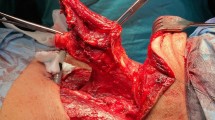Abstract
The extension of the surgery and closure type of the pharynx can be the determinants in the pharyngocutaneous fistula development. The objective of the study is to evaluate the incidence of pharingocutaneous salivary fistulae after total laryngectomies comparing manual and mechanical sutures. The study is designed as non-randomized, prospective clinical study. Sixty patients with squamous cell carcinoma were submitted to total laryngectomies. In 30 cases, the linear stapler (75 mm) closure (surgical technique described in details) and in other 30 cases manual suture was used. The cases of mechanical suture were prospective and consecutive and the cases of manual suture were a review series of patients who underwent a manual suture of pharynx, in the same period of time. The statistical analysis between the two groups concluded that both were comparable. Fistulae incidence was 6.7% (2/30) in the group with the mechanical suture and 36.7% (11/30) in the group with manual suture closure, presenting a significant difference (p = 0.0047). The total laryngectomy with mechanical closure is an easy and fast learning technique, allowing watertight closure of the pharynx with a low risk of contamination of the surgical field. It is an assured method, even in previously irradiated patients, since we respect the limits of its indication regarding the extension of primary tumor that must be confirmed by previous suspension laryngectomy performed in the operating room.



Similar content being viewed by others
References
Mäkitie AA, Irish J, Gullane PJ (2003) Pharyngocutaneous fistula. Curr Opin Otolaryngol Head Neck Surg 11:78–84. doi:10.1097/00020840-200304000-00003
McCombe AW, Jones AS (1993) Radiotherapy and complications of laryngectomy. J Laryngol Otol 107:130–132. doi:10.1017/S0022215100122406
Genden EM, Rinaldo A, Shara AR et al (2004) Pharyngocutaneous fistula following laryngectomy. Acta Otolaryngol 124:117–120. doi:10.1080/00016480310015191
Friedman M, Venkatesan TK, Yakolev A et al (1999) Early detection and treatment of postoperative pharungocutaneous fistula. Otolaryngol Head Neck Surg 121:378–380. doi:10.1016/S0194-5998(99)70224-X
Virtaniemi JA, Kumpulainen EJ, Hirvikoski PP et al (2001) The incidence and etiology of postlaryngectomy pharyngocutaneous fistulae. Head Neck 23:29–33. doi:10.1002/1097-0347(200101)23:1<29::AID-HED5>3.0.CO;2-P
Cavalot AL, Gervasio CF, Nazionale G et al (2000) Pharyngocutaneous fistula as a complication of total laryngectomy: review of the literature and analysis of case records. Otolaryngol Head Neck Surg 123:587–592. doi:10.1067/mhn.2000.110617
Johansen LV, Overgaard J, Elbrond O (1988) Pharyngo-cutaneous fistulae after laryngectomy: influence of previous radiotherapy and prophylactic metronidazole. Cancer 61:673–678. doi:10.1002/1097-0142(19880215)61:4<673::AID-CNCR2820610410>3.0.CO;2-C
Natvig K, Boysen M, Tausjo J (1993) Fistulae following laryngectomy in patients treated with irradiation. J Laryngol Otol 107:1136–1139. doi:10.1017/S0022215100125484
Hier M, Black MJ, Lafond G (1993) Pharyngocutaneous fistulas after total laryngectomy: incidence, etiology and outcome analysis. J Otolaryngol 22:164–166
Teknos TN, Myers LL, Bradford CR et al (2001) Free tissue reconstruction of the hypopharynx after organ preservation therapy: analysis of wound complications. Laryngoscope 111:1192–1196. doi:10.1097/00005537-200107000-00011
Sofferman AR, Voronetsky I (2000) Use of the linear stapler for pharyngoesofageal closure after total laringectomy. Laryngoscope 110:1406–1409. doi:10.1097/00005537-200008000-00035
Soylu L, Kiroglu M, Aydogan B et al (1998) Pharyngocutaneous fistula following laryngectomy. Head Neck 20:22–25. doi:10.1002/(SICI)1097-0347(199801)20:1<22::AID-HED4>3.0.CO;2-5
Westmore GA, Knowles JEA (1983) The use of a stapling instrument for post-laryngectomy pharyngeal repair. J Laryngol Otol 97:775–778
Agrawal A, Schuller DE (2000) Closed laryngectomy using the automatic linear stapling device. Laryngoscope 110:1402–1405. doi:10.1097/00005537-200008000-00034
Montoya FS, Galarreta JCR, Del Rey AS et al (2002) Comparative study between the use of manual versus mechanical sutures in the closing of the mucous defect following a total laryngectomy. Acta Otorrinolaringol Esp 53:343–350
Lukyanchenko AG (1971) Suturing of a laryngeal defect in laryngectomy. Vestn Otorinolaringol 33:29–30
Bedrin L, Ginsburg G, Horowitz Z et al (2005) 25-year experience of using a linear stapler in laryngectomy. Head Neck 27:1073–1079. doi:10.1002/hed.20280
Acknowledgments
Acknowledgments to the Head & Neck Services of Heliópolis Hospital (São Paulo city), Ana Costa Hospital (Santos city) and Luís Camargo da Fonseca e Silva Hospital (Cubatão city).
Conflict of interest statement
The Ethicon division of Johnson & Johnson gives us 10 Staplers–ILC-40–for use in the mechanical sutures in Santa Casa Medical School.
Author information
Authors and Affiliations
Corresponding author
Rights and permissions
About this article
Cite this article
Gonçalves, A.J., de Souza, J.A.L., Menezes, M.B. et al. Pharyngocutaneous fistulae following total laryngectomy comparison between manual and mechanical sutures. Eur Arch Otorhinolaryngol 266, 1793–1798 (2009). https://doi.org/10.1007/s00405-009-0945-4
Received:
Accepted:
Published:
Issue Date:
DOI: https://doi.org/10.1007/s00405-009-0945-4




